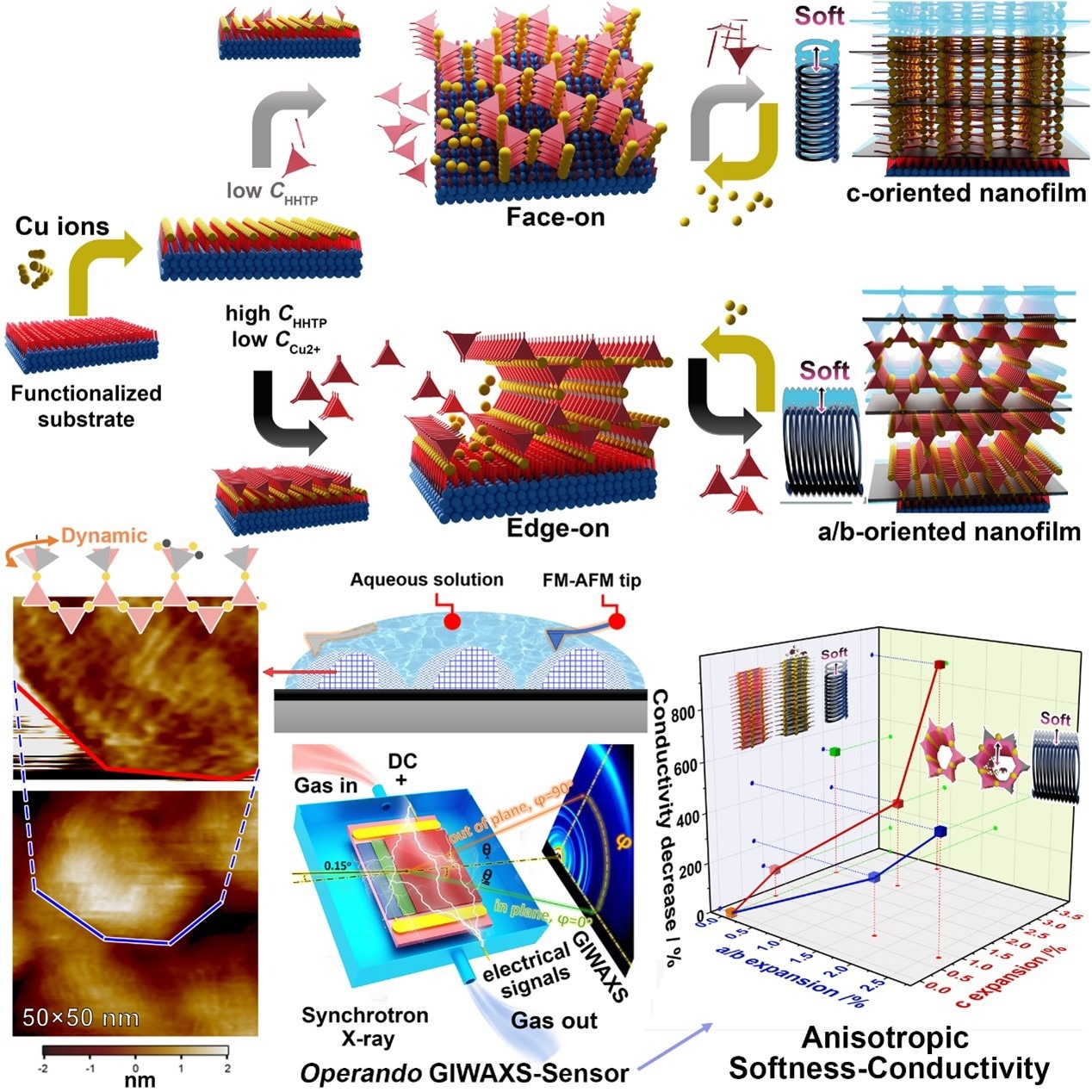Researchers from the Chinese Academy of Sciences’ Institute of Process Engineering (IPE) and Kyoto University have suggested an approach for growing ‘face-on’ and ‘edge-on’ conductive metal-organic frameworks (cMOF) nanofilms on substrates by controlling the “stand-up” behaviors of ligands on various surfaces to circumvent the difficulty in such film orientation control.
 Schematic showing the preparation of the conductive MOF thin films with reversal orientations, the lattice image obtained from FM-AFM, and the anisotropic softness-conductivity revealed by the operando GIWAXS-Sensor. Image Credit: YAO Mingshui
Schematic showing the preparation of the conductive MOF thin films with reversal orientations, the lattice image obtained from FM-AFM, and the anisotropic softness-conductivity revealed by the operando GIWAXS-Sensor. Image Credit: YAO Mingshui
They developed operando characterization methods employing atomic force microscopy and X-Rays to show the softness of the crystalline nanofilms and expose their unique conductive functionalities.
The study was published in PNAS on September 25, 2023.
Electrically cMOFs have progressively evolved as a result of the discovery of their ability to conduct charges in porous crystals. In most cases, cMOFs used in electrical devices hybridize with other materials, particularly substrates. As a result, careful management of the interface between cMOF and substrate is critical.
The unknown interface chemistry of cMOFs, on the other hand, makes controlled synthesis and advanced characterization of high-quality thin films extremely difficult. In particular, rather than the expected “edge-on” alignment of the 2D planes resulting from the hydrophilic -OH edge and the hydrophobic triphenylene core, the experimentally observed orientation is the “face-on” arrangement of the 2D planes on the substrates.
The challenge lies in inducing the necessary high surface pressure to achieve a 'standing up' configuration of the core.
Mingshui Yao, Study First Author and Professor, Institute of Process Engineering, Chinese Academy of Sciences
When exposed to high surface pressure, ligands with a hydrophobic core and a hydrophilic edge can adopt an upright orientation on hydrophilic surfaces using the Langmuir-Blodgett (LB) approach.
Inspired by the ‘standing up’ behaviors, we employ ultra-high concentration, together with vigorous evaporation during spraying, to create a unique local high surface pressure that can induce the ‘standing up’ of HHTP (HHTP = 2,3,6,7,10,11-hexahydrotriphenylene) ligands. Accordingly, the ‘face-on’ and ‘edge-on’ thin films can be fabricated.
Kenichi Otake, Study Corresponding Author and Professor, Kyoto University
Several credible analyses were performed to evaluate the crystallinity and orientation of ultra-thin films with thicknesses ranging from a few nanometers to tens of nanometers.
The operando GIWAXS imaging and electrical monitoring revealed the anisotropic framework softness associated with electrical conductivity on the cMOF nanofilm. It answers the question whether the generally considered rigid Cu-HHTP can be soft.
Susumu Kitagawa, Study Corresponding Author and Professor, Kyoto University
Aside from redox interactions, structural softness has been shown to alter electrical conductivity in an anisotropic manner.
Journal Reference:
Yao, M.- S., et al. (2023) Growth mechanisms and anisotropic softness–dependent conductivity of orientation-controllable metal–organic framework nanofilms. PNAS. doi:10.1073/pnas.2305125120